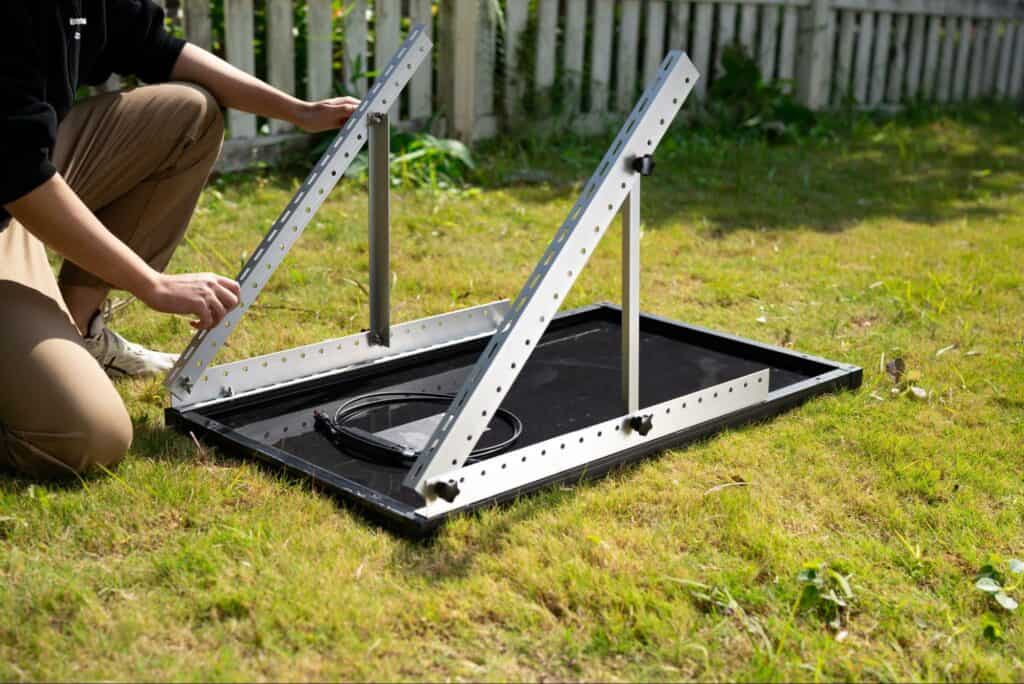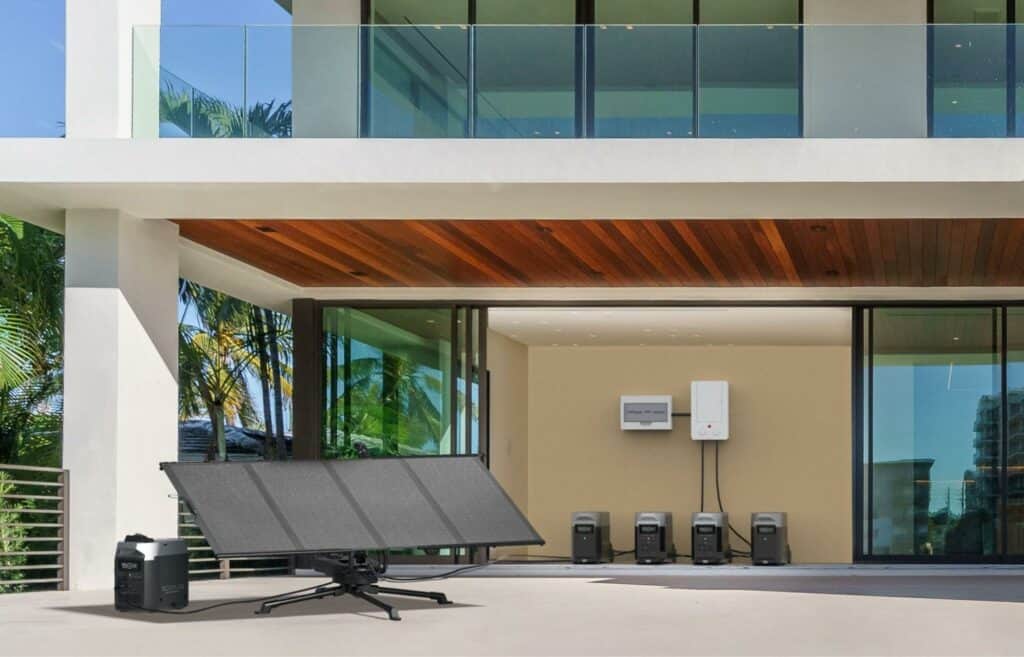Table of Contents
Photovoltaic (PV) modules — like solar panels — are essential to any renewable energy system that generates electricity from sunlight.
There are countless variations of PV modules like solar panels, roof tiles, and shingles, but they all rely on the same physical phenomenon to capture photons from sunshine and convert the energy into direct current (DC) electricity.
The fundamental scientific principle behind solar panel systems that generate electricity is almost 200 years old…
It’s called the photovoltaic effect.
Read on to find out how PV systems convert solar power into household electricity — and how solar panels work.
How Do Solar Panels Generate Power?
Unlike thermal solar energy systems, photovoltaic systems generate power from sunlight — not heat.
Here’s how it works.
The Solar Spectrum (Source: NASA).
Sunlight Absorption
The light energy the sun produces that reaches Earth comprises three primary types of electromagnetic radiation.
Each type of light is part of the solar spectrum that makes up solar irradiance — which measures the total amount of energy available from sunlight.
The three types of solar radiation that PV panels harness to generate electricity are:
- Visible Light
- Ultraviolet Light (UV)
- Infrared Light (IR)
Infrared and visible light comprise over 90% of the solar energy that penetrates the Earth’s atmosphere.
(Source: SMU.edu)
Infrared radiation is often harnessed to generate heat, but the photovoltaic effect — and solar panels — relies on the spectrum of visible light.
(Source: EIA)
Solar Cells and the Photovoltaic Effect
Solar panels utilise photovoltaic cells to harvest photons from visible sunlight and convert solar energy into direct current electricity.
Most PV modules rely on pure monocrystalline or polycrystalline silicon solar cells to produce the photovoltaic effect.
Other types of solar cells in commercial use include:
- Passive Emitter and Rear Contact (PERC)
- Thin Film
- Perovskite
According to the International Energy Agency, crystalline silicon (cSi) “remains the dominant technology for PV modules, with a market share of more than 97%.”
Crystalline silicon is a non-mechanical semiconductive material that uses insulation and conduction to generate voltage (positive and negative current).
When different wavelengths of sunlight from across the solar spectrum hit the surface of a PV module, photons either bounce off through reflection, pass through the photovoltaic material, or get absorbed by the solar cell.
Once absorbed, the photons provide the energy for the semiconductor material to generate electricity.
Photon capture causes negative “free electrons” to circulate within the PV cell and move towards the device’s front surface.
The circulation of electrons creates an electrical imbalance within the cell, resulting in voltage potential.
The positive and negative charge — similar to those carried by battery terminals — is absorbed by electrical conductors in the cell to produce electricity when connected to a load such as a solar inverter or battery.
Balance of System
Once PV modules generate direct current (DC) electricity, it is transmitted to a solar inverter for conversion to household (AC) power or a charge controller and solar battery for storage and later use.
Balance of System (BoS) in solar power refers to all the components required to generate and store electricity, other than the PV modules.
What are the Core Components of Solar Panels?
Most residential and utility-scale photovoltaic applications use rigid solar panels, while small off-grid systems may use flexible or portable solar panels.
Here are the core components of rigid solar panels.
Photovoltaic Cells
Solar cells are the essential component in every photovoltaic module and PV panel.
In most modules, PV cells are made from the following parts:
- A p-n junction (semiconductor) formed by doped monocrystalline or polycrystalline silicon wafers
- Anti-reflective coating or anti-reflective glass
- Printed silver paste (Front contact of the cell)
- Back surface field
- Printed aluminium paste (rear cell contact)
A 400W rigid solar panel typically contains around 60 photovoltaic cells.
Tempered Glass
Sometimes called “solar glass”, tempered glass that’s 3mm to 4mm thick is strong and durable enough to protects PV cells from extreme weather and dust while letting the sun shine through.
Ethylene Vinyl Acetate (EVA)
EVA is a transparent plastic that further protects the PV cells and holds them in place.
It encapsulates the solar cells under the tempered glass.
Back Sheet
A back sheet protects the rear of the panel and also acts as electrical insulation.
Aluminum Frame
The above components are housed and protected inside a metal frame.
Aluminium is frequently used for framing due to its lightness, durability, and low cost, although other metals can also be used.
Junction Box
The electrical junction box is mounted on the rear exterior of the panel.
It’s used to connect the PV panels in a solar array to each other and to the solar inverter or charge controller in your balance of system.

Mounting Hardware
Mounting hardware is required to securely install the solar panels — usually on a rooftop, balcony, or on the ground.
Cables and Wiring
Solar panels must be chained together in series or parallel — or a hybrid of both — and connected to your balance of system.
Most modern PV systems use Universal Solar Connectors, making interconnection simple and helping ensure cross-compatibility between manufacturers and components.

How Does a Solar Panel System Work?
PV modules, such as solar panels and shingles, are required in solar power systems that generate electricity, but they are not a standalone solution.
Solar panels produce direct current (DC) electricity, and the balance of system transforms the power for household use, storage, and/or transmission to the utility grid.
Residential solar power systems can be grid-tied, off-grid, or hybrid.
Required Components for On-grid Systems
- Solar Inverter
- Transfer Switch
- Bidirectional or smart meter
It’s essential to note…
Grid-tied systems DO NOT WORK during a blackout.
All on-grid solar power systems must include an auto-shutdown mechanism to prevent injury to utility workers and damage to infrastructure during power outages.
Grid-tied systems require permitting and inspection from your power or utility company.
Required Components for Off-Grid and Hybrid (Solar + Storage) Systems
*Optional. Required for integration with home circuitry and to provide an uninterruptible power supply (UPS) in a blackout.
The balance of system components in off-grid and hybrid solar systems can be standalone, or you can opt for an all-in-one solution like EcoFlow’s DELTA Pro expandable portable power station.
What is a Solar Inverter?
Solar panels produce direct current (DC) electricity.
DC electricity is commonly used in battery storage and other applications.
However, household electricity is alternating current (AC).
Solar inverters are essential in grid-tied systems to convert DC into AC electricity for immediate consumption or transmission to the utility grid.
In off-grid and hybrid solar power systems, DC electricity passes through a charge controller. It is routed for storage in a solar battery or to the inverter for immediate use.
The Role of a Solar Battery
All clean, renewable energy sources are intermittent.
Wind turbines don’t produce electricity on still days.
Solar panels don’t work at night.
Grid-tied solar power systems partially solve the problem of intermittency by connecting to the utility grid.
When your electricity consumption exceeds the supply from your solar panels, the bidirectional meter automatically switches to on-grid electricity.
If net metering is available in your location, you can sell the electricity that your solar panel array generates in excess of consumption back to the grid.
Net metering is rarely a money-making proposition, but it can help you save money on your electricity bills.
If you don’t have solar battery storage or net metering, any power your solar panels produce in excess of consumption simply goes to waste.
That’s not good, but here’s what’s worse…
On-grid solar panel systems SHUT DOWN during power outages.
The last few years have seen record-high temperatures and a rise in extreme weather events worldwide.
Australia is no different.
(Source: The Conversation)
Unless your only goal with installing a solar panel system is saving money, a hybrid or off-grid system is the right choice for you.
Hybrid systems offer you even more money-saving options by storing electricity for consumption during on-peak hours and only using grid power off-peak.
Frequently Asked Questions
Solar panels generate direct current (DC) electricity from sunlight using the photovoltaic effect. The DC electricity is transmitted to your balance of system — such as a solar inverter or charge controller — through cables. Off-grid and hybrid systems store power in a solar battery. Grid-tied systems switch between PV and utility power but don’t work in a blackout.
Final Thoughts
Photovoltaic modules like solar panels are the foundation of renewable energy systems that generate electricity from sunlight.
By investing in high-efficiency solar panels for your home, you can maximise the return on your solar investment.
EcoFlow offers a wide variety of off-grid and hybrid solar generator solutions and rigid, flexible, and portable solar panels with industry-leading performance.
Whether you’re looking to embrace renewable energy for home backup and save money on electricity bills or need a portable generator for off-grid adventures, EcoFlow has a solution for you.
Check out our selection today.


